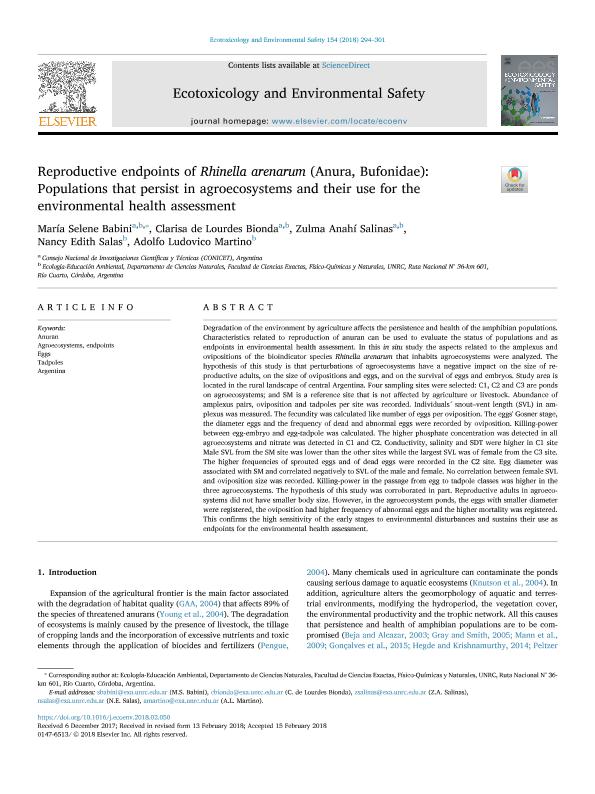Artículo
Reproductive endpoints of Rhinella arenarum (Anura, Bufonidae): Populations that persist in agroecosystems and their use for the environmental health assessment
Babini, María Selene ; Bionda, Clarisa de Lourdes
; Bionda, Clarisa de Lourdes ; Salinas, Zulma Anahí
; Salinas, Zulma Anahí ; Salas, Nancy Edith; Martino, Adolfo Ludovico
; Salas, Nancy Edith; Martino, Adolfo Ludovico
 ; Bionda, Clarisa de Lourdes
; Bionda, Clarisa de Lourdes ; Salinas, Zulma Anahí
; Salinas, Zulma Anahí ; Salas, Nancy Edith; Martino, Adolfo Ludovico
; Salas, Nancy Edith; Martino, Adolfo Ludovico
Fecha de publicación:
15/06/2018
Editorial:
Academic Press Inc Elsevier Science
Revista:
Ecotoxicology and Environmental Safety
ISSN:
0147-6513
Idioma:
Inglés
Tipo de recurso:
Artículo publicado
Clasificación temática:
Resumen
Degradation of the environment by agriculture affects the persistence and health of the amphibian populations. Characteristics related to reproduction of anuran can be used to evaluate the status of populations and as endpoints in environmental health assessment. In this in situ study the aspects related to the amplexus and ovipositions of the bioindicator species Rhinella arenarum that inhabits agroecosystems were analyzed. The hypothesis of this study is that perturbations of agroecosystems have a negative impact on the size of reproductive adults, on the size of ovipositions and eggs, and on the survival of eggs and embryos. Study area is located in the rural landscape of central Argentina. Four sampling sites were selected: C1, C2 and C3 are ponds on agroecosystems; and SM is a reference site that is not affected by agriculture or livestock. Abundance of amplexus pairs, oviposition and tadpoles per site was recorded. Individuals´ snout–vent length (SVL) in amplexus was measured. The fecundity was calculated like number of eggs per oviposition. The eggs’ Gosner stage, the diameter eggs and the frequency of dead and abnormal eggs were recorded by oviposition. Killing-power between egg-embryo and egg-tadpole was calculated. The higher phosphate concentration was detected in all agroecosystems and nitrate was detected in C1 and C2. Conductivity, salinity and SDT were higher in C1 site Male SVL from the SM site was lower than the other sites while the largest SVL was of female from the C3 site. The higher frequencies of sprouted eggs and of dead eggs were recorded in the C2 site. Egg diameter was associated with SM and correlated negatively to SVL of the male and female. No correlation between female SVL and oviposition size was recorded. Killing-power in the passage from egg to tadpole classes was higher in the three agroecosystems. The hypothesis of this study was corroborated in part. Reproductive adults in agroecosystems did not have smaller body size. However, in the agroecosystem ponds, the eggs with smaller diameter were registered, the oviposition had higher frequency of abnormal eggs and the higher mortality was registered. This confirms the high sensitivity of the early stages to environmental disturbances and sustains their use as endpoints for the environmental health assessment.
Palabras clave:
AGROECOSYSTEMS, ENDPOINTS
,
ANURAN
,
ARGENTINA
,
EGGS
,
TADPOLES
Archivos asociados
Licencia
Identificadores
Colecciones
Articulos(CCT - CORDOBA)
Articulos de CTRO.CIENTIFICO TECNOL.CONICET - CORDOBA
Articulos de CTRO.CIENTIFICO TECNOL.CONICET - CORDOBA
Citación
Babini, María Selene; Bionda, Clarisa de Lourdes; Salinas, Zulma Anahí; Salas, Nancy Edith; Martino, Adolfo Ludovico; Reproductive endpoints of Rhinella arenarum (Anura, Bufonidae): Populations that persist in agroecosystems and their use for the environmental health assessment; Academic Press Inc Elsevier Science; Ecotoxicology and Environmental Safety; 154; 15-6-2018; 294-301
Compartir
Altmétricas



